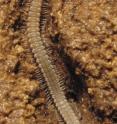Genetic study of cave millipedes reveals isolated populations and ancient divergence between species
The International Journal of Myriapodology recently published the first population genetic study of cave millipedes. This research highlights an important challenge in the conservation of cave biodiversity -- that for many species caves are 'islands' of habitat that support isolated and genetically distinct populations. The southern Cumberland Plateau in Tennessee and Alabama, USA is known for its high cave density. In addition, it has the highest cave biodiversity of any region in North America. Millipedes of the genus Tetracion range across this biodiversity hotspot. These millipedes, which can grow up to 8 cm in length, are common scavengers in cave communities. Like many cave animals, Tetracion millipedes have reduced pigmentation and non-functional eyes.
The authors used genetic techniques to compare Tetracion populations and species. They found that Tetracion populations were generally isolated from one another. In addition, divergence between Tetracion species was high, suggesting that members of the genus diverged several million years ago.


